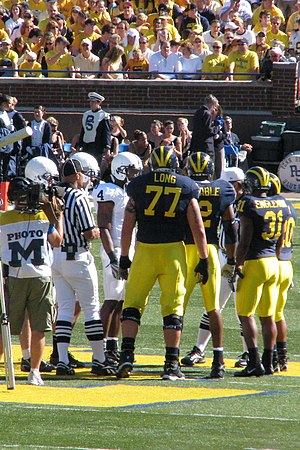 Image via Wikipedia
Image via Wikipedia
The following post about coin flips in poker tournaments is excellent and comes from rakemeback. In the next day or two, I will post my perspective on this issue of coin flips when it comes to tournaments where most of us compete; that is, where the increase in blinds increase every 20 minutes or less and forces the action a lot faster than in a major event.
Coin Flips
No player has ever won a MTT without having won several coin-flips during the event. Like it or not (and people mostly do not like it) sometimes that’s what your tournament life comes down to: a coin-flip, and it’s quite inevitable too. Regardless of the structure of the tournament and regardless of how well you play, you won’t ever even make it to a final table without gaining Lady Luck’s approval first, through a few lucky coin-flips.
A poker coin-flip is about getting your money all-in on 50-50 (or approximately 50-50) odds. Now, if it’s not obvious to you, those are not good odds on an investment on which you stake your tournament life. If may be ok in a cash game and it may carry a marginal EV+ there, but given the finite nature of your tourney stack, that is definitely not the case in tournaments. In a cash game, if you lose, you just repot or reload and you’re back in action, pushing your marginal EV+ and eventually walking away with the dough.
If you’re in a tournament though, once you’re felted, it’s all over. There’s no coming back: you’ve lost. That’s why it’s not exactly optimal to go all-in on such odds. None of the players who shove on such a coin-flip do it out of their own will though. They’re always forced by the circumstances to make the move. In a cash game, if you see the odds you get are no good, you can afford to just sit back and wait for another – much better- opportunity. In a poker tournament, such luxury is unheard-of. Is there anything you can do to better your odds at a coin flip? There sure is.
When to make the do-or-die move
Whether or not to go all-in on a coin-flip is not something you can choose, but you can choose when you make the do-or-die move. Every time a coin-flip comes about, one player makes the move and the other player calls him. A layman may think that it doesn’t matter who makes the move and who makes the call, the bottom line is that the player who’s all-in is neck deep in trouble. A poker player knows though, that things are not that simple.
There’s a little thing called the fold equity which gives the guy doing the shoving an advantage over the guy doing the calling. How is that? The guy who shoves all-in has two possibilities to win the pot: either his hand goes to a showdown and wins the pot hands down, or his opponent folds and he takes the pot without a showdown. The guy doing the calling has only one way to win: by winning the showdown. That’s a huge difference when it comes to staying alive in a poker tournament.
Pick your coin-flip spots well and be the aggressor rather than the caller. If you’re always the aggressor on coin-flips, you’ll win more such 50-50 match-ups than you’ll lose in the long-run and given how essential coin-flips are in tournaments, that will amount to a great edge.
Make sure the coin-flip on which you stake your tournament life is indeed a coin-flip. You do not want to turn your cards over and see that you’re a 30-70 underdog just because you misread your opponent. That there is no longer a con flip.
Sign up for rakeback. Rakeback deals and poker prop deals offer you a rebate on your tournament fees, which will save you a lot of money in the long-run. Rake rebate deals (like the ones Rakemeback has), are not just for cash game players. They work just fine in tournaments too.
By the way:
Here is a classic coin flip. What made this so funny is that when Bettis came off the field his coach was angry with him for not calling tails. And Bettis is heard yelling back in a frustrated tone, "I called tails!" Too bad the video did not capture this moment.








No comments:
Post a Comment